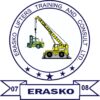
Our specialty and custom training services are made-to-order classes that address your unique safety training needs. Instruction can take place where it best suits your company either at Erasko’s training facility or the location of your choice.
Industrial Training, Compliance and Certification
Erasko provides both standard and customized industrial safety training and instruction for a broad range of workplace requirements. Our hands-on, no-compromise approach ensures your satisfaction and more importantly, your worker’s safety.
Our standard training classes provide instruction for typical and mandated safety requirements. Our certified instructors and hands-on approach ensures that your standards are met and your employees’ safety is secure. Our standard instructional formats include classroom lectures, audio-visual presentations, crisis simulations and seminars.
Standard safety training classes include:
- Back Safety and Safe Lifting
- Crane Rigging Safety
- Crane Operation and Planning
- Hazardous Material Awareness (IMDG)
- Fall Prevention and Protection
- Hearing protection
- Fire Safety and Fire Watch
- Forklift Operator
- Hazard Communications
- Personal Protective Equipment (PPE)
- Respiratory Protection
- Scaffold Safety
- Substance (Drug and Alcohol) Abuse
- Client Safety Policies and Procedures
- Driving Safety
- Electrical Safety for Non-Electrical Workers
- General Safety
- Hazard Recognition
- Job Safety Analysis (JSAs)
Course Duration:
Length of the program is determined by the type of program selected.
Support material
Noise & Hearing Protection
One in 10 Americans has a hearing loss that affects his or her ability to understand normal speech. Excessive noise exposure is the most common cause of hearing loss.
Can Noise Really Hurt My Ears?
Yes, noise can be dangerous. If it is loud enough and lasts long enough, it can damage your hearing.
The damage caused by noise, called sensorineural hearing loss or nerve deafness, can be caused by several factors other than noise, but noise-induced hearing loss is different in one important way, it can be reduced or prevented altogether.
Can I “Toughen Up” My Ears?
No. If you think you have grown used to a loud noise, it probably has damaged your ears, and there is no treatment, no medicine, no surgery, not even a hearing aid that completely restores your hearing once it is damaged by noise.
How Does the Ear Work?
The ear has three main parts: the outer, middle, and inner ear. The outer ear (the part you can see) opens into the ear canal. The eardrum separates the ear canal from the middle ear. Small bones in the middle ear help transfer sound to the inner ear. The inner ear contains the auditory (hearing) nerve, which leads to the brain.
Any source of sound sends vibrations or sound waves into the air. These funnel through the ear opening, down the ear canal, and strike your eardrum, causing it to vibrate. The vibrations are passed to the small bones of the middle ear, which transmit them to the hearing nerve in the inner ear. Here, the vibrations become nerve impulses and go directly to the brain, which interprets the impulses as sound: music, a slamming door, a voice, etc.
When noise is too loud, it begins to kill the nerve endings in the inner ear. As the exposure time to loud noise increases, more and more nerve endings are destroyed. As the number of nerve endings decreases, so does your hearing. There is no way to restore life to dead nerve endings; the damage is permanent.
How Can I Tell If A Noise Is Dangerous?
People differ in their sensitivity to noise. As a general rule, noise may damage your hearing if you have to shout over background noise to make yourself heard, the noise hurts your ears, it makes your ears ring, or you have difficulty hearing for several hours after exposure to the noise.
Sound can be measured scientifically in two ways. Intensity, or loudness of sound, is measured in decibels. Pitch is measured in frequency of sound vibrations per second. A low pitch, such as a deep voice or a tuba, makes fewer vibrations per second than a high voice or violin.
What Does Frequency Of Sound Vibration Have To Do With Hearing Loss?
Frequency is measured in cycles per second, or Hertz (Hz). The higher the pitch of the sound, the higher the frequency.
Young children, who generally have the best hearing, can often distinguish sounds from about 20 Hz, such as the lowest note on a large pipe organ, to 20,000 Hz, such as the high shrill of a dog whistle that many people are unable to hear.
Human speech, which ranges from 300 to 4,000 Hz, sounds louder to most people than noises at very high or very low frequencies. When hearing impairment begins, the high frequencies are usually lost first, which is why people with hearing loss often have difficulty hearing the high pitched voices of women and children. Loss of high frequency hearing also can distort sound, so that speech is difficult to understand even though it can be heard. People with hearing loss often have difficulty detecting differences between certain words that sound alike, especially words that contain S, F, SH, CH, H, or soft C sounds, because the sound of these consonants is in a much higher frequency range than vowels and other consonants.
What About Decibels?
Intensity of sound is measured in decibels (dB). The scale runs from the faintest sound the human ear can detect, which is labeled 0 dB, to over 180 dB, the noise at a rocket pad during launch.
Decibels are measured logarithmically. This means that as decibel intensity increases by units of 10, each increase is10 times the lower figure. Thus, 20 decibels is 10 times the intensity of 10 decibels, and 30 decibels is 100 times as intense as 10 decibels.
Approx. Decibel Level Example
Approx. Decibel Level | Example |
0 | Faintest sound heard by human ear. |
30 | Whisper, quiet library. |
60 | Normal conversation, sewing machine, typewriter. |
90 | Lawnmower, shop tools, truck traffic; 8 hours per day is the maximum exposure to protect 90% of people. |
100 | Chainsaw, pneumatic drill, snowmobile; 2 hours per day is the maximum exposure without protection. |
115 | Sandblasting, loud rock concert, auto horn; 15 minutes per day is the maximum exposure without protection. |
140 | Gun muzzle blast, jet engine; noise causes pain and even brief exposure injures unprotected ears. Maximum allowed noise with hearing protectors. |
How High Can the Decibels Go Without Affecting My Hearing?
Many experts agree that continual exposure to more than 85 decibels is dangerous.
Does The Length Of Time I Hear A Noise Have Anything To Do With The Danger To My Hearing?
It certainly does. The longer you are exposed to a loud noise, the more damaging it may be. Also, the closer you are to the source of intense noise, the more damaging it is.
Every gunshot produces a noise that could damage the ears of anyone in close hearing range. Large bore guns and artillery are the worse because they are the loudest. But even cap guns and firecrackers can damage your hearing if the explosion is close to your ear. Anyone who uses firearms without some form of ear protection risks hearing loss.
Recent studies show an alarming increase in hearing loss in youngsters. Evidence suggests that loud rock music along with increased use of portable radios with earphones may be responsible for this phenomenon.
Can Noise Affect More Than My Hearing?
A ringing in the ears, called tinnitus, commonly occurs after noise exposure, and it often becomes permanent. Some people react to loud noise with anxiety and irritability, an increase in pulse rate and blood pressure, or an increase in stomach acid. Very loud noise can reduce efficiency in performing difficult tasks by diverting attention from the job.
Who Should Wear Hearing Protectors?
If you must work in an excessively noisy environment, you should wear protectors. You should also wear them when using power tools, noisy yard equipment, or firearms, or riding a motorcycle or snowmobile.
What Are The Laws For On-The-Job Exposure?
- Habitual exposure to noise above 85 dB will cause a gradual hearing loss in a significant number of individuals, and louder noises will accelerate this damage.
- For unprotected ears, the allowed exposure time decreases by one-half for each 5 dB increase in the average noise level. For instance, exposure is limited to 8 hours at 90 dB, 4 hours at 95 dB, and 2 hours at 100 dB.
- The highest permissible noise exposure for the unprotected ear is 115 dB for 15 minutes/day. Any noise above 140 dB is not permitted.
The Occupational Safety and Health Administration, in its Hearing Conservation Amendment of 1983, requires hearing conservation programs in noisy work places. This includes a yearly hearing test for the approximately five million workers exposed to an average of 85 dB or more of noise during an 8-hour work day.
Ideally, noisy machinery and work places should be engineered to be more quiet or the worker’s time in the noise should be reduced; however, the cost of these actions is often prohibitive. As an alternative, individual hearing protectors are required when noise averages more than 90 dB during an 8-hour day.
When noise measurements indicate that hearing protectors are needed, the employer must offer at least one type of earplug and one type of earmuff without cost to employees. If the yearly hearing tests reveal hearing loss of 10 dB or more in higher pitches in either ear, the worker must be informed and must wear hearing protectors when noise averages more than 85 dB for an 8-hour day.
Larger losses of hearing and/or the possibility of ear disease should result in referral to an ear, nose and throat physician (otolaryngologist).
What Are Hearing Protectors? How Effective Are They?
Hearing protection devices decrease the intensity of sound that reaches the eardrum. They come in two forms: earplugs and earmuffs.
Earplugs are small inserts that fit into the outer ear canal. They must be snugly sealed so the entire circumference of the ear canal is blocked. An improperly fitted, dirty or worn-out plug may not seal and can irritate the ear canal. They are available in a variety of shapes and sizes to fit individual ear canals and can be custom made. For people who have trouble keeping them in their ears, they can be fitted to a headband.
Earmuffs fit over the entire outer ear to form an air seal so the entire circumference of the ear canal is blocked, and they are held in place by an adjustable band. Earmuffs will not seal around eyeglasses or long hair, and the adjustable headband tension must be sufficient to hold earmuffs firmly around the ear.
Properly fitted earplugs or muffs reduce noise 15 to 30 dB. The better earplugs and muffs are approximately equal in sound reductions, although earplugs are better for low frequency noise and earmuffs for high frequency noise.
Simultaneous use of earplugs and muffs usually adds 10 to 15dB more protection than either used alone. Combined use should be considered when noise exceeds 105 dB.
Why Can’t I just Stuff My Ears With Cotton?
Ordinary cotton balls or tissue paper wads stuffed into the ear canals are very poor protectors; they reduce noise only by approximately 7 dB.
What Are The Common Problems Of Hearing Protectors?
Studies have shown that one-half of the workers wearing hearing protectors receive one-half or less of the noise reduction potential of their protectors because these devices are not worn continuously while in noise or because they do not fit properly.
A hearing protector that gives an average of 30 dB of noise reduction if worn continuously during an 8-hour work day becomes equivalent to only 9 dB of protection if taken off for one hour in the noise. This is because decibels are measured on a logarithmic scale, and there is a 10-fold increase in noise energy for each 10 dB increase.
During the hour with unprotected ears, the worker is exposed to 1,000 times more sound energy than if earplugs or muffs had been worn.
In addition, noise exposure is cumulative. So the noise at home or at play must be counted in the total exposure during any one day. A maximum allowable while on-the-job followed by exposure to a noisy lawnmower or loud music will definitely exceed the safe daily limit.
Even if earplugs and/or muffs are worn continuously while in noise, they do little good if there is an incomplete air seal between the hearing protector and the skin.
When using hearing protectors, you will hear your own voice as louder and deeper. This is a useful sign that the hearing protectors are properly positioned.
Can I Hear Other People And Machine Problems If I Wear Hearing Protectors?
Just as sunglasses help vision in very bright light, so do hearing protectors enhance speech understanding in very noisy places. Even in a quiet setting, a normal-hearing person wearing hearing protectors should be able to understand a regular conversation.
Hearing protectors do slightly reduce the ability of those with damaged hearing or poor comprehension of language to understand normal conversation. However, it is essential that persons with impaired hearing wear earplugs or muffs to prevent further inner ear damage.
It has been argued that hearing protectors might REDUCE a worker’s ability to hear the noises that signify an improperly functioning machine. However, most workers readily adjust to the quieter sounds and can still detect such problems.
What If My Hearing Is Already Damaged? How Can I Tell?
Hearing loss usually develops over a period of several years. Since it is painless and gradual, you might not notice it. What you might notice is a ringing or other sound in your ear (called tinnitus), which could be the result of long-term exposure to noise that has damaged the hearing nerve. Or, you may have trouble understanding what people say; they may seem to be mumbling, especially when you are in a noisy place such as in a crowd or at a party. This could be the beginning of high-frequency hearing loss; a hearing test will detect it.
If you have any of these symptoms, you may have nothing more serious than impacted wax or an ear infection, which might be simply corrected. However, it might be hearing loss from noise. In any case, take no chances with noise—the hearing loss it causes is permanent. If you suspect a hearing loss, consult a physician with special training in ear care and hearing disorders (called an otolaryngologist or otologist). This doctor can diagnose your hearing problem and recommend the best way to manage it.
Hearing protection includes ear plugs and earmuffs that are made to reduce the intensity or loudness of sound.
Ear plugs are placed into the ear canal so that they totally block the canal. They come in various pre-made shapes and sizes, or they can be custom-made by taking an impression of the ear. Ear plugs can reduce noise 15-30 dB depending on how they are made and fit.
Ear muffs fit completely over both ears. Again, they must fit tightly so that sound is blocked from entering the ears. Like earplugs, muffs can reduce noise 15-30 dB depending on how they are made and fit.
Ear plugs and ear muffs can be used together to achieve even greater sound reduction. Use of ear plugs and ear muffs is recommended when noise exposure is particularly high
Cotton in the ears is not considered appropriate ear protection. It cannot effectively block the ear canal. It has been found to reduce sound by only 5-7 dB.
Client Portfolio
Erasko Lifters and Training Consult Limited has been dedicated to and involved in industrial, warehousing, and manufacturing equipment training since 2008, which accounts for its partnerships with institutions here in Ghana. Below are some of the companies we have worked with so far.











